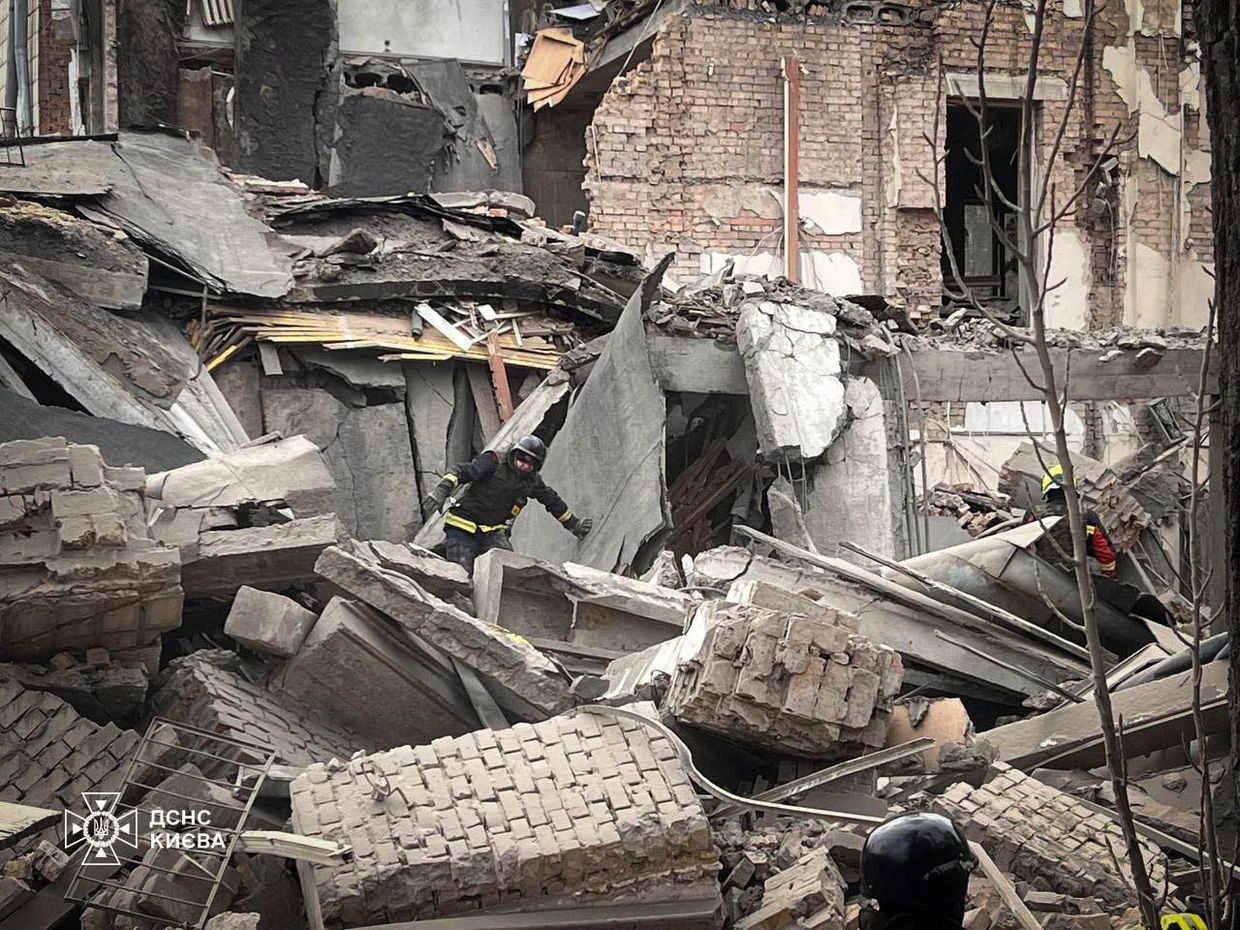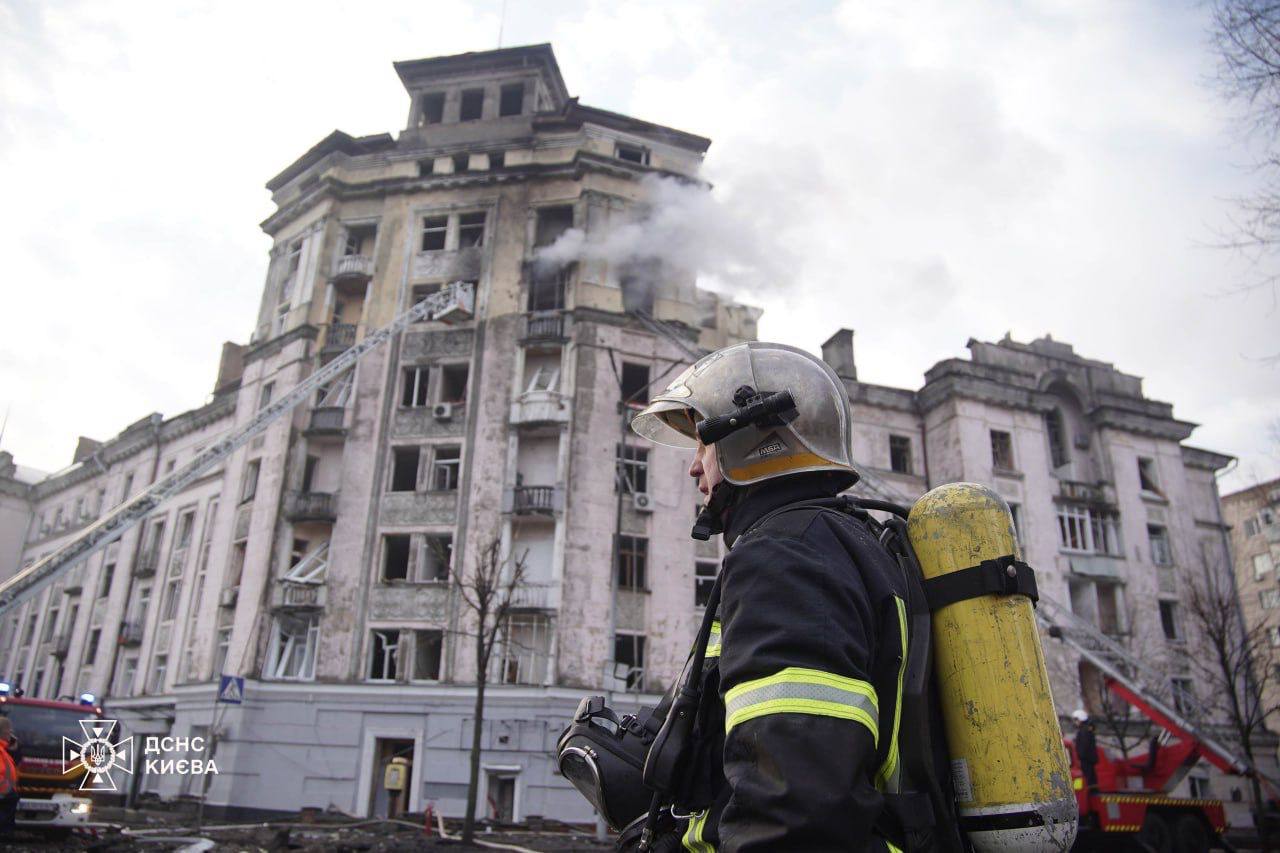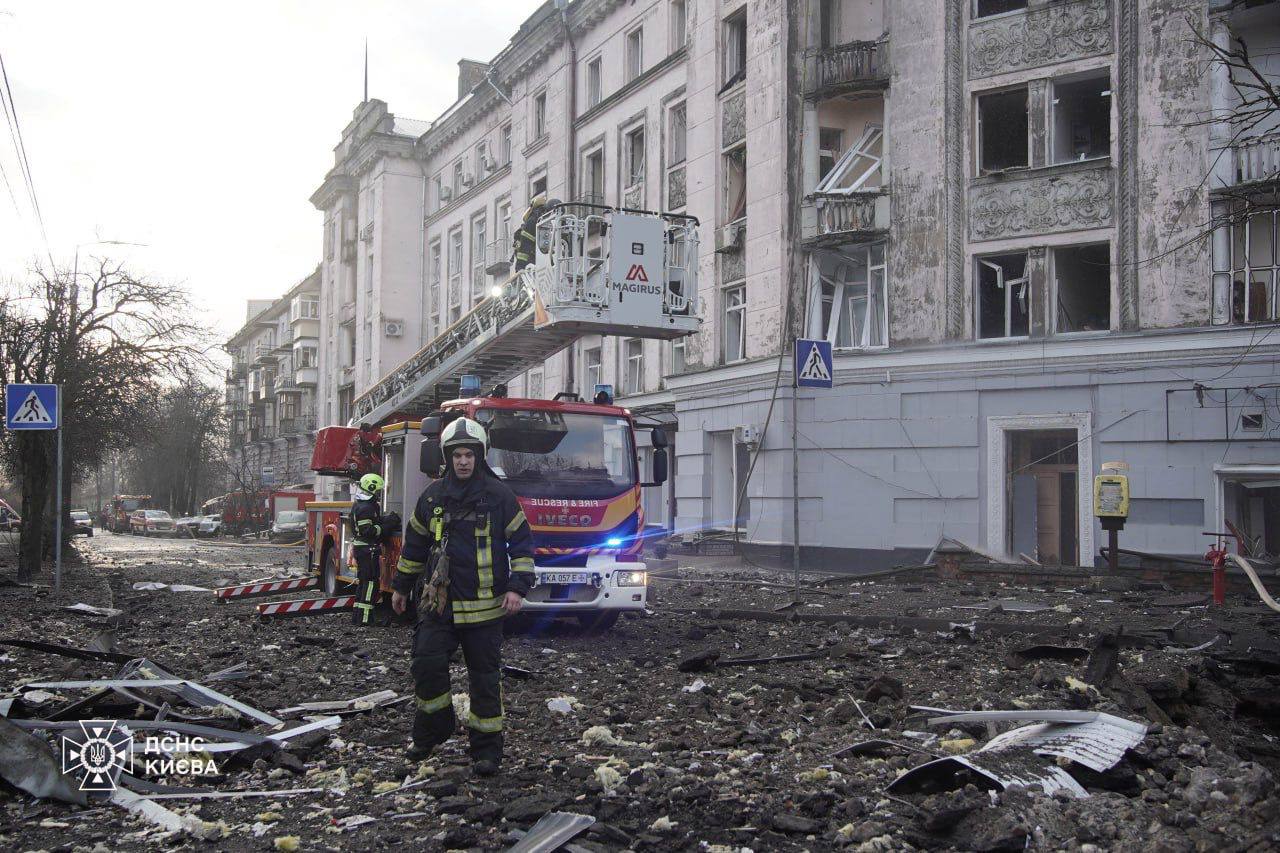
Russia aims to knock out Ukraine's power grid in new wave of attacks
The aftermath of a Russian strike on the Dnipro Dam in Zaporizhzhia, Ukraine, on March 22, 2024. (Prime Minister Denys Shmyhal/Telegram)
Editor's note: The article was updated on March 27 with comments from Roman Nitsovych, a research director at DiXi Group.
Russia launched a fresh wave of missile and drone attacks against Ukraine between March 21-25, hitting the country's critical infrastructure heavier than ever before.
Some 190 missiles, 140 Shahed-type drones, and 700 aerial bombs pounded the country over the past week, President Volodymyr Zelensky said in his evening address on March 24.
A day later, Russia launched a new missile attack on Kyiv.
Experts agree that Moscow's goal is to knock out the country's power grid. While it has failed to achieve this aim so far, the situation grows ever more precarious with dwindling air defense ammunition.
Some believe the new attacks to be retribution for Ukraine's own campaign of drone strikes against Russian oil refineries, which have reportedly disrupted Russia's oil production capacity by roughly one-tenth.
"Russia resumed attacks against energy facilities in Ukraine in retaliation for Kyiv's recent drone attacks against Russian oil depots and refineries," said Frederico Borsari, a defense analyst and a fellow at the Center for European Policy Analysis (CEPA).
"The aim was to show strength and resolve to the Russian population and at the same time try to break the Ukrainian spirit to resist by depriving both the population and the military of critical energy supplies."
Others say that the attack was conducted by Russia when it had the capacity to do so, not because of Ukraine's military action.
"There could be a very simple answer: they weren't ready before. The attack was very precisely prepared and realized in a very detailed manner," said Oleksandr Kharchenko, the managing director of the Energy Industry Research Center.
"This preparation was not done in one week or two weeks... They precisely planned this attack. Its main target was a national blackout."
Largest strike on energy grid
Ukrainian and Western officials warned that Moscow is likely to launch a massive campaign against the country's power grid, echoing the strategy it used in late 2022 and early 2023.
The campaign was expected in the winter months to inflict maximum damage.
During the first autumn and winter of the full-scale war, waves of Russian missiles and drones, at that time unopposed by advanced air defenses like the Patriots, destroyed half of the country's energy infrastructure and left people across Ukraine without heat amid sub-zero temperatures.
This winter, Russia seemed to have shifted its strategy, seeking to degrade Ukraine's military–industrial complex rather than its energy system.
With relatively limited damage dealt to critical infrastructure, the grid remained stable, and the country even managed to go through the entire winter using only its own gas.
The largest-ever attack came, unexpectedly, in early spring, with the temperatures already on the rise.
The capital was hit already on March 21, marking the start of this new series of attacks.
A day later, Russia launched a devastating strike against the country's power grid across regions. At least five people were killed and dozens injured on March 22 in what Energy Minister Herman Halushchenko dubbed the largest attack against the country's energy infrastructure in history.
Russian missiles targeted western regions on March 24, damaging the facilities of the Naftogaz gas operator.
On March 25, a new strike against Kyiv injured two people, while attacks against southern Ukraine injured over a dozen. Anxiety grows over how long this campaign can continue – and how much harm and destruction it can bring.
Energy facilities were hit across the country, including Zaporizhzhia's Dnipro Hydroelectric Power Plant, Ukraine's largest hydroelectric station.
Ihor Syrota, the head of Ukraine's state-owned Ukrhydroenergo enterprise, said that entire units of the hydroelectric plant had been destroyed after they took several direct hits, adding that building them up from scratch could take between 18 to 24 months.
The plant's full restoration will likely take years, representing a "significant loss for the Ukrainian energy system," Syrota said on television.
The dam itself was damaged as well but officials stressed there is currently no danger of a breach – as long as Russia does not renew its attacks. Its potential destruction could emulate the catastrophe unleashed by the breach of the Kakhovka Dam last year.
"Due to shelling, DTEK (Ukraine's largest private energy company) lost half of its generating capacity on Friday (March 22), which, unfortunately, cannot be quickly restored," DTEK's spokesperson Pavlo Bilodid told the Kyiv Independent.
Oleksii Kuleba, the deputy head of the presidential office, said that almost 1.5 million people experienced power outages on March 22. Some 700,000 lost power in Kharkiv alone, where devastating damage dealt to the city's thermal power plant resulted in a blackout.
Russia "destroyed the main energy facilities that fed our city," Mayor Ihor Terekhov concluded. As the thermal power plant will likely take more than a year to restore, Kharkiv is now supplied with energy from other regions of Ukraine.
Kharkiv ended its heating season a few weeks ahead of schedule, while Kyiv is expected to follow suit on March 28.
Outages were also experienced by residents of Zaporizhzhia, Odesa, Sumy, Poltava, and Vinnytsia oblasts and elsewhere.
"Tonight, the enemy repeatedly attacked the energy infrastructure of Odesa, which had previously been heavily damaged by shelling," Bilodid said on March 25. Odesa Oblast remains the most heavily affected region, he added.
While energy workers managed to stabilize the situation in Ukraine somewhat over the weekend, emergency shutdowns still had to be introduced in Odesa Oblast. Around 300,000 people in Odesa remain without electricity as of March 25, Governor Oleh Kiper reported.
Aiming for a blackout
The warm weather likely provided at least a partial relief to citizens and the power system, raising a question: why did Russia launch the attack only now?
Experts believe Russia was not fully ready prior and had involved deep strategic planning, possibly for months.
Speaking on television, Ukrenergo CEO Volodymyr Kudrytskyi said that these preparations likely involved consultations with Russian energy experts, who are well familiar with Ukraine's energy infrastructure.
"I have no doubt that all the attacks against Ukraine's energy grid since the start of the full-scale invasion have been coordinated with Russian energy experts in one way or another," Kudrytskyi said.
While the attack no doubt dealt a heavy blow, it has failed to achieve a total blackout, and Kharchenko believes that even the large-scale outages that the country suffered during the first winter are unlikely to repeat.
"We understand how they plan these attacks, and we understand how to react immediately afterward to prevent a blackout," Kharchenko said.
"This experience, and already installed physical defense on energy sites, is enough to prevent a real nationwide blackout," he added.
Roman Nitsovych, a research director at DiXi Group, agreed that a total "blackout is hardly possible."
Ukrainian citizens may still experience some "scheduled outages, especially in big cities that were affected (by the attacks)," Nitsovych added, naming Odesa as an example.
Ukraine has been able to adapt and gain new capabilities it did not possess during the previous winter season. Despite dwindling ammunition supplies, modern air defense systems that Ukraine received last year still continue to dull the edge of the strikes.
Ukrainian defenses downed all 31 missiles launched on March 21, 92 of the 151 projectiles launched on March 22, 43 out of the 57 on March 24, and both ballistic missiles fired against Kyiv on March 25.
Should the attacks continue, however, Kyiv may soon find itself without sufficient means to protect its sky. As $60 billion in U.S. aid remains effectively blocked in Congress, the Washington Post wrote that Ukraine's air defenses may soon be able to target only one out of every five Russian missiles.
Borsari linked Russia's renewed attacks on energy systems directly with the ammunition shortages.
"The Kremlin also perceives that Ukraine is now struggling on the battlefield due to ammunition shortages and attacking critical infrastructure also fixes important, high-end air defense capabilities that could be used elsewhere and burns through Ukraine's interceptor stocks," the expert commented.
"Further attacks against energy infrastructure would put additional stress on Ukrainian civilians and challenge regular power supply also critical for smooth military operations, in particular considering Ukraine's highly digitized command and control architecture."
As for Ukraine's energy workers, they are better prepared to handle the stress on the energy grid than during the first year of the invasion: "We already have huge experience in how to minimize the result of the attacks... and to renew energy supplies to suffering regions," Kharchenko said.
Nevertheless, fully repairing the inflicting damage is a tall order, especially for a country in the middle of a full-scale war.
"Ukraine already has a huge lack of generation capacities... High voltage can be restored quite fast, but when we are talking about generation capacity, the lowest estimate (for restoring it) is two years," Kharchenko noted.
The aftermath of the recent attacks may also be felt more strongly during the coming summer months.
"In the long-term, we will have less flexible capacity in the grid, namely in the summer during the maintenance of nuclear and thermal power plants, which could lead to deficit in certain days," Nitsovych explained.
DTEK's spokesperson provided a somber prognosis on restoration efforts: "Due to the significant scale of destruction, it is difficult to estimate how long it will take to restore the damaged equipment fully."
"Unfortunately, Ukraine alone cannot restore energy facilities damaged by the enemy. We need the help of our Western partners, who could provide us with the necessary equipment," Bilodid stressed.
















